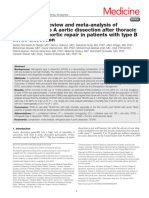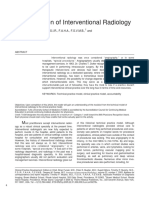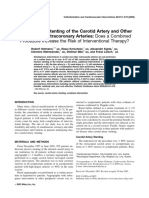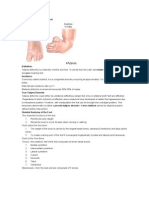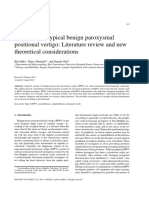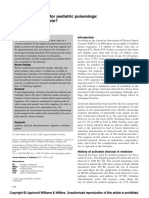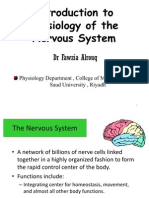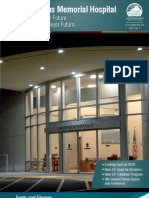President's: The Legacy of Andreas Gruentzig
President's: The Legacy of Andreas Gruentzig
Uploaded by
gelezetaCopyright:
Available Formats
President's: The Legacy of Andreas Gruentzig
President's: The Legacy of Andreas Gruentzig
Uploaded by
gelezetaOriginal Description:
Original Title
Copyright
Available Formats
Share this document
Did you find this document useful?
Is this content inappropriate?
Copyright:
Available Formats
President's: The Legacy of Andreas Gruentzig
President's: The Legacy of Andreas Gruentzig
Uploaded by
gelezetaCopyright:
Available Formats
Catheterization and Cardiovascular Diagnosis 38:331 (1996)
@he
President's Page
Conflict or Collaboration:
The Legacy of Andreas Gruentzig
The scope of interventional cardiology continues to tion table. Similar issues are relevant in patients with
change. This change is the result of several factors in- peripheral vascular disease involving the renal arteries,
cluding among others technical improvements such as the aortoiliac, or femoral systems. Again, similar factors
the introduction and widespread use of intracoronary are central to potential conflict.
stents and the recognition that diseases in noncardiac These conflicts were not part of the mind set of An-
vascular beds can be addressed with devices similar to dreas Gruentzig, who instead was a bridge builder be-
those used to treat coronary artery stenoses. The initial tween several disciplines. Current practitioners can learn
pioneers in the field of intravascular treatment were in- much from his initial approach. The Andreas Gruentzig
terventional radiologists. The techniques were then re- Society recently met for its semiannual meeting and ad-
fined and adapted for the treatment of cardiac disease by dressed many of the issues of modern interventional
Andreas Gruentzig, leading to the first patient procedure treatment as interventional radiologists, vascular sur-
performed September 16, 1977. Early interchanges in- geons, neurologists, neuroradiologists, and invasive car-
volved interventional radiologists, cardiologists, and an- diologists were present and participated. A particular fo-
giologists in a collaborative effort from which everyone cus interface was the increasing interest in extracranial
benefited greatly, physicians and patients alike. carotid angioplasty and stenting. The goals of therapy
Subsequently, the field of interventional cardiology and assessment of therapeutic outcomes are best served
has experienced exponential growth in procedures as by keeping the patient foremost in consideration. The
well as the development of new devices, such as ather- approach with a new technique such as treatment of ex-
ectomy, lasers, and stents; the latter, stents, have been tracranial carotid disease should be multidisciplinary,
particularly important adjuncts to balloon angioplasty . with involvement of neuroradiology, vascular radiology,
Throughout this time, other developments have occurred neurology, and invasive cardiology. In addition, input
that have been less positive. One of the more notable from surgical colleagues is often very helpful. Identifi-
developments has been the growth of either absolute or cation of the optimal treatment strategy involves consid-
relative antipathy between interventional radiologists and eration of anatomy and comorbid conditions, as well as
cardiologists and more recently between interventional technical considerations. For these processes, a multidis-
cardiologists and neuroradiologists. The growing antip- ciplinary approach that sets aside regional conflicts is
athy between the latter two groups relates to the appli- optimal and should indeed be requisite.
cation of percutaneous techniques to treat extracranial Advances in therapy are sometimes dramatic, such as
carotid stenoses. Central to the perceived conflict are the introduction of percutaneous transluminal coronary
several factors, including (1) control of patients, (2) ac- angioplasty (FTCA), and are sometimes characterized by
cess to new technology, and (3) concern as to the co- slow continued improvements, also illustrated by the
morbid conditions that often exist in this patient popula- continued development of PTCA. The goal of identify-
tion. On the one hand, invasive cardiologists have far ing optimal treatments for our patients is best served by
more experience with intravascular stents and angio- collaboration and free and open discourse about shared
plasty techniques; in addition, they are more experienced problems, rather than strident posturing and conflict.
in the care of the coexisting cardiac disease and, if need
be, can treat the cardiac disease during the same proce-
dure. On the other hand, neuroradiologists or some vas- David R . Holmes, J r . , MD.
cular radiologists have a better knowledge of the anat- Division of Cardiovascular Diseases
omy of both extracranial and intracranial vessels and are Mayo Clinic
more experienced in cannulation of these vessels. Both Rochester, Minnesota
disciplines bring valuable information to the catheteriza-
0 1996 Wiley-Liss, Inc.
You might also like
- Musculoskeletal Cancer Surgery - Malawer PDFDocument592 pagesMusculoskeletal Cancer Surgery - Malawer PDFanggita100% (1)
- Cerebral PalsyDocument97 pagesCerebral PalsyPrernaSharma100% (5)
- President's: The Legacy of Andreas GruentzigDocument1 pagePresident's: The Legacy of Andreas GruentziggelezetaNo ratings yet
- Femoral Pseudoaneurysms Post-Cardiac Catheterization Surgically Treated: Evolution and PrognosisDocument6 pagesFemoral Pseudoaneurysms Post-Cardiac Catheterization Surgically Treated: Evolution and Prognosishoumaishag77No ratings yet
- MedicineDocument16 pagesMedicineArtemisNo ratings yet
- NEJMoa 1710261Document14 pagesNEJMoa 1710261jcandela1No ratings yet
- Management of Epistaxis in Patients With Ventricular Assist Device: A Retrospective ReviewDocument6 pagesManagement of Epistaxis in Patients With Ventricular Assist Device: A Retrospective ReviewDenta HaritsaNo ratings yet
- 259 - Cervical Carotid Revascularization Indications From An Endovascular PerspectiveDocument3 pages259 - Cervical Carotid Revascularization Indications From An Endovascular PerspectiveИван ДимитровNo ratings yet
- Perioperative Management - Drug-Eluting StentsDocument12 pagesPerioperative Management - Drug-Eluting Stentskrisbot1991No ratings yet
- Sila 2023 - Middle Meningeal Artery Embolization Versus Surgery On Patients With Chronic Subdural Hematoma - No More Fence SittingDocument10 pagesSila 2023 - Middle Meningeal Artery Embolization Versus Surgery On Patients With Chronic Subdural Hematoma - No More Fence SittingCoAss - Fakhriza HidayatiNo ratings yet
- Short - and Long-Term Outcomes at A Single InstitutionDocument7 pagesShort - and Long-Term Outcomes at A Single InstitutionJonathan Frimpong AnsahNo ratings yet
- Atm 08 23 1626Document12 pagesAtm 08 23 1626Susana MalleaNo ratings yet
- Trend 42 VascentersDocument1 pageTrend 42 VascentersBingDelaCruzNo ratings yet
- Risk Factors For Intraprocedural Rupture During Emergency Endovascular Treatment of Ruptured Anterior Communicating Artery Aneurysms - PMCDocument13 pagesRisk Factors For Intraprocedural Rupture During Emergency Endovascular Treatment of Ruptured Anterior Communicating Artery Aneurysms - PMCpayamseydo2No ratings yet
- Neurosurgeons As Complete Stroke Doctors The Time Is NowDocument2 pagesNeurosurgeons As Complete Stroke Doctors The Time Is NowariNo ratings yet
- The Evolution of Interventional RadiologyDocument4 pagesThe Evolution of Interventional Radiologyturi gauNo ratings yet
- Perioperative Hemodynamic MonitoringDocument9 pagesPerioperative Hemodynamic MonitoringjayezmenonNo ratings yet
- Pci Versus Cabg in Cad, Serruys (2009)Document12 pagesPci Versus Cabg in Cad, Serruys (2009)Henrique MachadoNo ratings yet
- Deep Venous Thrombosis After Orthopedic PDFDocument7 pagesDeep Venous Thrombosis After Orthopedic PDFAnh Nguyen HuuNo ratings yet
- Intracranial Atherosclerotic Disease Current Concepts in Medical and Surgical ManagementDocument14 pagesIntracranial Atherosclerotic Disease Current Concepts in Medical and Surgical ManagementSantiago FuentesNo ratings yet
- PCI StrategyDocument14 pagesPCI StrategyJason WinathaNo ratings yet
- Bauer 2014Document8 pagesBauer 2014zixzaxoffNo ratings yet
- Metastatic Spine Disease: A Guide to Diagnosis and ManagementFrom EverandMetastatic Spine Disease: A Guide to Diagnosis and ManagementRex A. W. MarcoNo ratings yet
- 1 s2.0 S2772930322004367 MainDocument15 pages1 s2.0 S2772930322004367 MainVimal NishadNo ratings yet
- SYNTAXDocument11 pagesSYNTAXRodrigo BarreraNo ratings yet
- 1 s2.0 S1053077019303039 MainDocument6 pages1 s2.0 S1053077019303039 MainADELIAADENo ratings yet
- Hypertension: New and Future ChallengesDocument6 pagesHypertension: New and Future ChallengesangelNo ratings yet
- AneDocument12 pagesAneyuritrujillo33No ratings yet
- Impacto de Prehabi en TAVIDocument10 pagesImpacto de Prehabi en TAVIPatricio DelgadilloNo ratings yet
- Sdauijknficskdla Jidalksnd JkcmaszDocument9 pagesSdauijknficskdla Jidalksnd Jkcmasz0395No ratings yet
- Coronary Artery Disease Literature ReviewDocument4 pagesCoronary Artery Disease Literature Reviewaflsvwoeu100% (1)
- Guias ASRA 2010 Anestesia Regional en Paciente AnticoaguladoDocument38 pagesGuias ASRA 2010 Anestesia Regional en Paciente AnticoaguladoJonathan Tipon Galvis100% (1)
- Poise-3 (Nejm 2022)Document12 pagesPoise-3 (Nejm 2022)Jesus MujicaNo ratings yet
- Yatsynovich 2017 Cardiac SarcoidosiDocument64 pagesYatsynovich 2017 Cardiac SarcoidosiJohan ArocaNo ratings yet
- Non - Cardiac Surgery in Patients With Coronary Artery Disease: Risk Evaluation and Periprocedural ManagementDocument21 pagesNon - Cardiac Surgery in Patients With Coronary Artery Disease: Risk Evaluation and Periprocedural ManagementCesar EspejoNo ratings yet
- Pen Surgery For Thoracoabdominal Aortic Aneurysm-Is It Still A Horrible SurgeryDocument11 pagesPen Surgery For Thoracoabdominal Aortic Aneurysm-Is It Still A Horrible SurgeryJonathan Frimpong AnsahNo ratings yet
- Evolving Science of Trauma Resus 2021-06-17 17-57-30Document22 pagesEvolving Science of Trauma Resus 2021-06-17 17-57-30Paulina CastilloNo ratings yet
- The Growing Number of Adults SurvivingDocument2 pagesThe Growing Number of Adults SurvivingGabriela GhissardiNo ratings yet
- UhlemannDocument8 pagesUhlemannWilliam KamarullahNo ratings yet
- Percutaneous Transluminal Coronary Angioplasty (PTCA) and Stenting - Study of 100 CasesDocument7 pagesPercutaneous Transluminal Coronary Angioplasty (PTCA) and Stenting - Study of 100 CasesLuqy Luqman EffendyNo ratings yet
- Viral Myocarditis: A Paradigm For Understanding The Pathogenesis and Treatment of Dilated CardiomyopathyDocument7 pagesViral Myocarditis: A Paradigm For Understanding The Pathogenesis and Treatment of Dilated CardiomyopathyLeslie Noelle GarciaNo ratings yet
- Practice Guidelines For The Use of Imaging in Transient Ischemic Attacks and Acute StrokeDocument32 pagesPractice Guidelines For The Use of Imaging in Transient Ischemic Attacks and Acute StrokeVictor Guerra MartinsNo ratings yet
- Catheter Ablation in End Stage Heart FailureDocument10 pagesCatheter Ablation in End Stage Heart FailureJose Gomez MorenoNo ratings yet
- Successful Surgical Management of Large Pulmonary Artery 2024 InternationalDocument5 pagesSuccessful Surgical Management of Large Pulmonary Artery 2024 InternationalRonald QuezadaNo ratings yet
- Evolving Approaches To The Iliacs, Femorals, Popliteals, and RenalsDocument12 pagesEvolving Approaches To The Iliacs, Femorals, Popliteals, and RenalsSohil ElfarNo ratings yet
- Endovascular Stentgraft Placement in Aortic Dissection A MetaanalysisDocument10 pagesEndovascular Stentgraft Placement in Aortic Dissection A MetaanalysisCiubuc AndrianNo ratings yet
- Thoracic Aortic SyndromesDocument28 pagesThoracic Aortic SyndromesfionalilydebonisNo ratings yet
- Nej Mo A 2306037Document10 pagesNej Mo A 2306037Shrey SinghNo ratings yet
- Critical Care for Potential Liver Transplant CandidatesFrom EverandCritical Care for Potential Liver Transplant CandidatesDmitri BezinoverNo ratings yet
- Endovascular Treatment of Aortic Aneurysms and Dissection - 2022 - Seminars in VDocument14 pagesEndovascular Treatment of Aortic Aneurysms and Dissection - 2022 - Seminars in VDiego RodriguesNo ratings yet
- Pi Is 0007091217540015Document10 pagesPi Is 0007091217540015Yoga WibowoNo ratings yet
- The Polytrauma Patient Current Concepts And.3Document6 pagesThe Polytrauma Patient Current Concepts And.3Renan FerrariNo ratings yet
- The Transradial Approach To Percutaneous Coronary InterventionDocument9 pagesThe Transradial Approach To Percutaneous Coronary InterventionYashinta MaharaniNo ratings yet
- Surgical Intervention For Peripheral Arterial DiseaseDocument15 pagesSurgical Intervention For Peripheral Arterial DiseaseDewi NurNo ratings yet
- Pulmonary Endarterectomy: Experience and Lessons Learned in 1,500 CasesDocument8 pagesPulmonary Endarterectomy: Experience and Lessons Learned in 1,500 CasesRoxana Maria MunteanuNo ratings yet
- CCD 10652Document6 pagesCCD 10652khadharyassineNo ratings yet
- Radial Artery Access For Peripheral Endovascular ProceduresDocument6 pagesRadial Artery Access For Peripheral Endovascular Proceduresvam buddhaNo ratings yet
- Principles of Cardiac Anaesthesia: Learning ObjectivesDocument5 pagesPrinciples of Cardiac Anaesthesia: Learning ObjectivesFitri AmaliahNo ratings yet
- The Transradial Approach To Percutaneous Coronary InterventionDocument9 pagesThe Transradial Approach To Percutaneous Coronary InterventionDeebanshu GuptaNo ratings yet
- Niedical: Access To Heart Surgery For SmokersDocument1 pageNiedical: Access To Heart Surgery For SmokersCristina BălănescuNo ratings yet
- New England Journal Medicine: The ofDocument11 pagesNew England Journal Medicine: The ofCyntia AndrinaNo ratings yet
- 10 1111@trf 15148Document3 pages10 1111@trf 15148anupa000No ratings yet
- Biomechanics Orthotics AssignmentDocument16 pagesBiomechanics Orthotics AssignmentChrono_YuNo ratings yet
- ECMO For COVID-19 Patients in Europe and Israel: LetterDocument5 pagesECMO For COVID-19 Patients in Europe and Israel: LetterJackson ErasmoNo ratings yet
- Premature Rupture of MembraneDocument7 pagesPremature Rupture of MembranedrommygreatNo ratings yet
- Obstetrics and GynaecologyDocument7 pagesObstetrics and GynaecologyRashed Shatnawi100% (1)
- Prophylactic Cervical Cerclage (Modified Shirodkar Operation) For Twin and Triplet Pregnancies After Fertility TreatmentDocument8 pagesProphylactic Cervical Cerclage (Modified Shirodkar Operation) For Twin and Triplet Pregnancies After Fertility TreatmentAiraNo ratings yet
- Peds PresentationDocument31 pagesPeds Presentationapi-247218432No ratings yet
- Prenatal ScreeningDocument6 pagesPrenatal Screeningapi-253447748No ratings yet
- FINALE - ResearchDocument14 pagesFINALE - ResearchDarryle Clven Ace BorjaNo ratings yet
- Medical Certificate: SignatureDocument2 pagesMedical Certificate: Signature6843. ravjot singhNo ratings yet
- Pilot Study of The Pediatric Eating Assessment Tool Pedi EATDocument33 pagesPilot Study of The Pediatric Eating Assessment Tool Pedi EATANGIE GRAJALESNo ratings yet
- Woods LampDocument2 pagesWoods LampAstri Kusuma DewiNo ratings yet
- ABA ThearpyDocument20 pagesABA ThearpyNazneen AwanNo ratings yet
- Pediatric Tics - Chap 17 - IngleDocument42 pagesPediatric Tics - Chap 17 - Ingleultraswamy100% (1)
- Guideline On Bahavior Pediatric Dental PatientDocument13 pagesGuideline On Bahavior Pediatric Dental PatientSeptriyani KaswindiartiNo ratings yet
- Talipes Deformity or ClubfootDocument5 pagesTalipes Deformity or ClubfootcrisolandNo ratings yet
- BVVP Tipico y AtipicoDocument9 pagesBVVP Tipico y AtipicoCarolina OjedaNo ratings yet
- OctreotideDocument4 pagesOctreotideMihaela VișanNo ratings yet
- Overview of Child Health NursingDocument22 pagesOverview of Child Health NursingnatalieshirleyNo ratings yet
- Toronto Notes Nephrology 2015 33Document1 pageToronto Notes Nephrology 2015 33JUSASBNo ratings yet
- Activated CharcoalDocument7 pagesActivated CharcoalyayaNo ratings yet
- Clinical Audit On One Hour Sepsis Bundle in Our HospitalDocument2 pagesClinical Audit On One Hour Sepsis Bundle in Our HospitalAnonymous lAfk9gNPNo ratings yet
- Gastrointestinal BleedingDocument14 pagesGastrointestinal BleedingDevesh RaiNo ratings yet
- Introduction To Physiology of The Nervous System (CLS, Allied Medical Student)Document34 pagesIntroduction To Physiology of The Nervous System (CLS, Allied Medical Student)Cristina PopescuNo ratings yet
- Dr. Justin Holtzman, MD Joins HealthPoint Plus As Chief Medical OfficerDocument2 pagesDr. Justin Holtzman, MD Joins HealthPoint Plus As Chief Medical OfficerPR.comNo ratings yet
- Hazel Hawkins Memorial Hospital Newsletter 2011 Vol 1Document12 pagesHazel Hawkins Memorial Hospital Newsletter 2011 Vol 1Fernando PerezNo ratings yet
- Latest Affiliation Rules University of SargodhaDocument10 pagesLatest Affiliation Rules University of SargodhaShahid Ahmed HeeraNo ratings yet
- Resum MohammediaDocument3 pagesResum Mohammediasetata7128No ratings yet
- Cast, Brace, Traction CompilationDocument13 pagesCast, Brace, Traction CompilationMar Ordanza100% (1)




